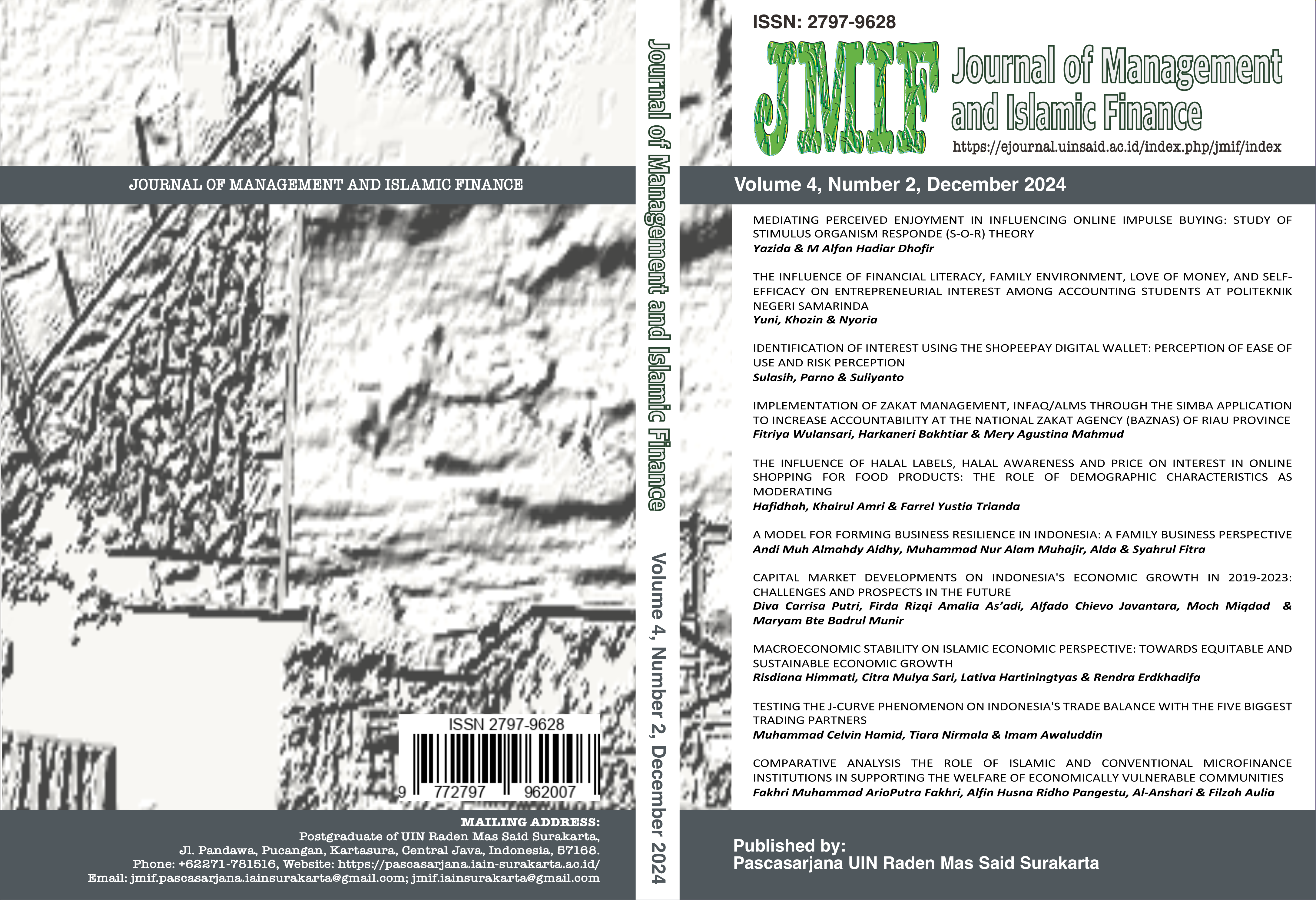COMPARATIVE ANALYSIS THE ROLE OF ISLAMIC AND CONVENTIONAL MICROFINANCE INSTITUTIONS IN SUPPORTING THE WELFARE OF ECONOMICALLY VULNERABLE COMMUNITIES
DOI:
https://doi.org/10.22515/jmif.v4i2.10407Keywords:
Microfinance Institutions, Community Welfare, conventional vs shariaAbstract
Downloads
References
Ahmad, S., Lensink, R., & Mueller, A. (2020). The double bottom line of microfinance: A global comparison between conventional and Islamic microfinance. World Development, 136, 105130. https://doi.org/10.1016/j.worlddev.2020.105130
Ahmad, W. (2022). The Role of Islamic Microfinance in Poverty Alleviation: Evidence from Pakistan. Journal of Economic Impact, 4(1), 39–49. https://doi.org/10.52223/jei4012205
Alamgir, D. A. H., Hassan, M. K., & Dewan, H. H. (2010). A Comparative Review of Islamic Versus Conventional Microfinance In Bangladesh. 8th International Conference on Islamic Economics and Finance, 1–35.
Amsami, M., Mamman, A., & Lawal, N. M. (2021). The Role of Islamic Microfinance on Poverty Alleviation : A Case. The International Journal Of Business & Management, 9, 171–181.
Ben Abdelkader, I., & Mansouri, F. (2019). Performance of microfinance institutions in the MENA region: a comparative analysis. International Journal of Social Economics, 46(1), 47–65. https://doi.org/10.1108/IJSE-06-2017-0242
Darwanto, Roessali, W., Woyanti, N., Salam, A. N., & Santosa, P. B. (2019). Sharia Microfinance Institutions Financing Model for Strengthening Agricultural Sector. IOP Conference Series: Earth and Environmental Science, 292(1). https://doi.org/10.1088/1755-1315/292/1/012016
Fianto, B. A., Gan, C., Hu, B., & Roudaki, J. (2018). Equity financing and debt-based financing: Evidence from Islamic microfinance institutions in Indonesia. Pacific Basin Finance Journal, 52(September 2017), 163–172. https://doi.org/10.1016/j.pacfin.2017.09.010
Hidayati, N., & Rusyadi, R. (2022). Faktor-Faktor Peternak Muslim Memilih Pinjaman Ke Lembaga Keuangan Konvensional (Studi Pada Peternak Desa Sumberjo Kecamatan Sanankulon Kabupaten Blitar). Jurnal Penelitian Mahasiswa Ilmu Sosial, Ekonomi, Dan Bisnis Islam (SOSEBI), 2(1), 2808–7089.
Iqbal, Z., & Mirakhor, A. (2012). Financial Inclusion : Islamic Finance Perspective. Journal of Islamic Business and Management, 2(1), 35–64. https://doi.org/10.12816/0004974
Jahharudin. (2021). “Tulisan popular wakaf, ekonomi dan bisnis” (Issue August). Pustaka Learning Center.
Jimoh, A. T., Kolawole, K. D., & Bamigbade, D. (2024). Islamic microfinance as a panacea for poverty alleviation. European Journal of Islamic Finance, 17–30. https://doi.org/10.1007/978-3-319-95714-2_125
Junjunan, M. I., Nawangsari, A. T., Melania, A. A., & Putikadyanto, A. P. A. (2022). A Comparative Study on Financial Performance between Islamic and Conventional Banking in Indonesia During the COVID-19 Pandemic. Muqtasid: Jurnal Ekonomi Dan Perbankan Syariah, 12(2), 75–88. https://doi.org/10.18326/muqtasid.v12i2.75-88
Kijkasiwat, P., & Phuensane, P. (2020). Innovation and Firm Performance: The Moderating and Mediating Roles of Firm Size and Small and Medium Enterprise Finance. Journal of Risk and Financial Management, 13(5). https://doi.org/10.3390/jrfm13050097
Masyita, D. (2017). Islamic microfinance institutions in Indonesia and the challenges in the supply chain perspectives. International Journal of Supply Chain Management, 6(4), 341–350.
Maulina, R., Dhewanto, W., & Faturohman, T. (2023). The integration of Islamic social and commercial finance (IISCF): Systematic literature review, bibliometric analysis, conceptual framework, and future research opportunities. Heliyon, 9(11), e21612. https://doi.org/10.1016/j.heliyon.2023.e21612
Mohd Thas Thaker, M. A. Bin, Bin Mohd Thas Thaker, H., Bin Allah Pitchay, A., & Akbar, M. A. (2021). a Proposed Integrated Islamic Crowdfunding - Microfinance (Iicm) Model for Poverty Reduction: a Case Study of Indonesia. International Journal of Islamic Economics and Finance Research, 4(1 July), 15–25. https://doi.org/10.53840/ijiefer45
Rahman, A., Rahman, M. T., & Belas, J. (2017). Determinants of SME Finance: Evidence from Three Central European Countries. Review of Economic Perspectives, 17(3), 263–285. https://doi.org/10.1515/revecp-2017-0014
Ramadhani, M., & Habib, M. A. F. (2021). Praktik Kartel Dalam Perspektif Hukum Bisnis Syariah. Juornal of Economics and Policy Studies, 2(2), 1–12. https://doi.org/10.21274/jeps.v2i2.4795
Riwajanti, N. I. (2013). Islamic Microfinance in Indonesia: A Comparative Analysis between Islamic Financial Cooperative (BMT) and Shari’ah Rural Bank (BPRS) on Experiences, Challenges, Prospects, and Roles in Developing Microenterprises [Durham University]. https://doi.org/10.1080/00074918.2014.980385
Uddin, M. N., Saad, N. B., Ismail, Y. Bin, & Nahar, L. (2020). Comparative Analysis of Microfinance Governance: Implications for Impact of Social Inequality and Poverty Reduction. Asian Journal of Economics and Empirical Research, 7(1), 33–47.
Downloads
Published
Issue
Section
Citation Check
License
Copyright (c) 2025 Fakhri Muhammad ArioPutra Fakhri, Alfin Husna Ridho Pangestu, Al-Anshari, Filzah Aulia

This work is licensed under a Creative Commons Attribution-ShareAlike 4.0 International License.
Authors who publish with this journal agree to the following terms:
- Authors retain copyright and grant the journal right of first publication with the work simultaneously licensed under a Creative Commons Attribution License that allows others to share the work with an acknowledgement of the work's authorship and initial publication in this journal.
- Authors are able to enter into separate, additional contractual arrangements for the non-exclusive distribution of the journal's published version of the work (e.g., post it to an institutional repository or publish it in a book), with an acknowledgement of its initial publication in this journal.
- Authors are permitted and encouraged to post their work online (e.g., in institutional repositories or on their website) prior to and during the submission process, as it can lead to productive exchanges, as well as earlier and greater citation of published work.






